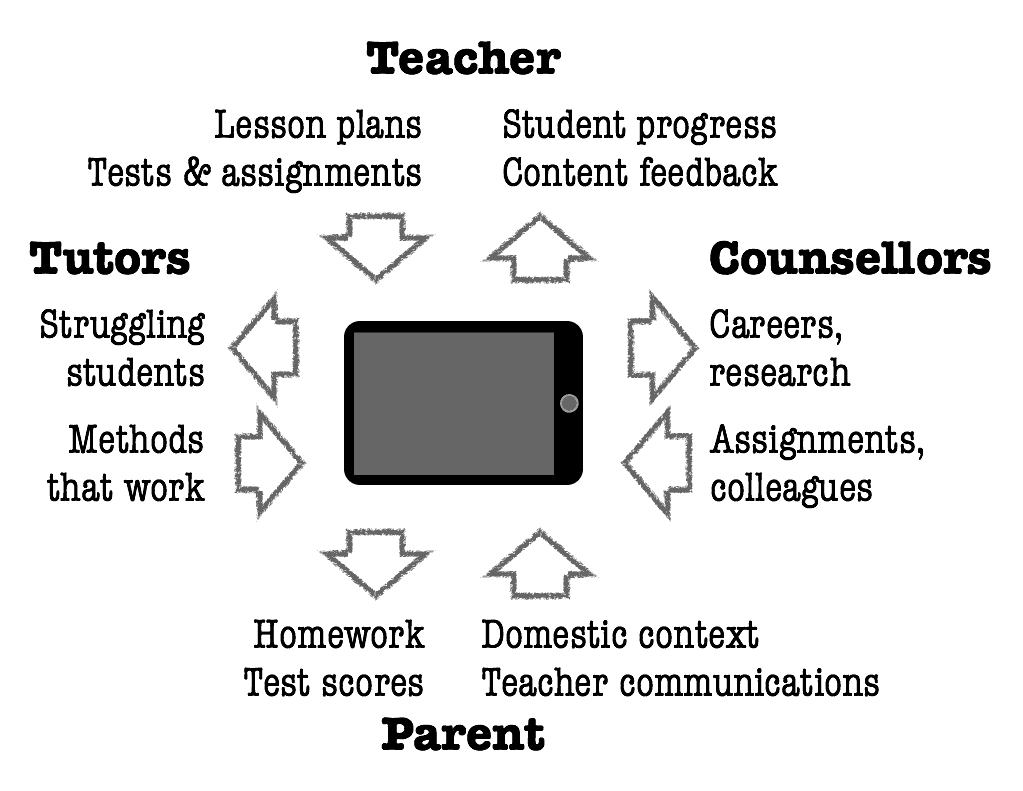Part two: Tablets could change the fate of the Western World
In this four-part series, we look at the impact of tablet computing on education: how tablets can save North American students, but how their ability to collect and analyze how students learn will make teaching more accountable — something that unions will oppose aggressively as they try to protect their members’ jobs.
This is a detailed write-up of the Short Bit I first presented at Bitnorth 2010, with lots of background and links to references I found while putting together that presentation. We decided to break it into several parts to make it easier to digest.
Yesterday, we looked at the sorry state of Western education. Now we’re going to consider the ways in which a digital classroom — made manifest by the modern tablet — could reverse the decline.
Digital education isn’t a new idea. The One Laptop Per Child (OLPC) project started shipping cheap, reliable computers to students years ago, and the Web has been a critical resource for many rural and remote schools. But it’s the arrival of ubiquitous tablet computing that can really transform the modern classroom.
If students have their own tablets, they’re equipped with a powerful platform for learning. Here’s why:
1. They’re your entire curriculum
Consider an interactive tablet for education. It’s not just a book: it’s a musical instrument, a fitness trainer, an artistic canvas, a research system, a design tool. It would be an integral part of every class, from science to arts to shop.
The OLPC initiative has put XO laptops into the hands of 1.4 million children worldwide. The results of that experiment? Children teach their parents to read; students are absent from class less often; and teachers report that they love teaching.
2. They’re your library
A tablet is the planet’s biggest book. Armed with a tablet, a student would have the world’s content at her fingertips. The iPad may be first-generation device that doesn’t have a camera, or a microphone, or a GPS, in it yet. But it has millions of resources for students, such as:
- The Elements, an exploration of the periodic table that’s linked to online systems like Wolfram Alpha
- Toy Story, the interactive book that includes read-out-loud and painting modes
- The Khan Academy, a YouTube channel from a retired investment banker that has roughly 1,200 educational videos he’s made
- The MIT Open Courseware project, which puts the university’s curriculum and course materials online for anyone in the world
- Wikipedia, the pinnacle of Clay Shirky’s Cognitive Surplus, with (at last count) 3,391,351 articles on nearly everything
When books were made of atoms, publishers could control their distribution. But that model is in ruins, and we’re creating free, open content at a breakneck rate.
As Shirky points out, the huge gains in free time that came about from industrialization were largely consumed by the television, a passive, one-way device we watch for 200 billion hours a year. But the advent of the Internet has unleashed a huge cognitive surplus on humanity. We created Wikipedia — a true wonder of the online world — in just 100 million hours: a fraction of the time we spend watching TV in a single year.
OLPC’s strategy for their next-generation tablet is to ship each device headed for a particular community with a different set of a hundred books. Then, using peer-to-peer sharing, the community has a vast library: a village with a hundred students would have 10,000 books in its digital library.
3. They’re getting affordable
In The Diamond Age, our heroine grows up in a world of nanotechnology. It’s cheap to make anything, simply by writing the proper code and setting tiny machines loose in a vat of goo. But we’re not so lucky: tablets cost money.
Fortunately, they’re coming down in price. The Indian government recently announced a $35 tablet, which was likely a publicity stunt — the raw components cost $47 — but still shows the shape of things to come. The first OLPC struggled to cost under $200, but now a $75 one may be within reach based on the affordably priced Marvell chipset.
There are also Linux implementations on the horizon and both handheld gaming and mobile phones are driving down the price point of portable devices. Today, a $50 phone has a Java engine, camera, speaker, microphone, and more.
Even if tablets are expensive, they’re still cheaper than the alternative. Printed textbooks are a $4.3B a year industry, dominated by a few large publishers who frequently edit their books to encourage students to buy new ones rather than resorting to cheaper used texts. The average high school student has 7 textbooks worth $70 to $90 each; by contrast, a Kindle costs around $260, and an iPad around $600, but eBooks pricing means the total cost of a year’s books is lower than the printed alternative.
The economics are so attractive that the Italian government has just stated that starting in 2011, teachers can only use books that are available partly or entirely online. They estimate a 90% savings of the €200 to €250 a year spent on books per student. Tablets also tackle many of the issues that made student notebooks expensive: they have no hinges, keyboards, or mice.
4. They’re personalized and interactive
Tablets are more than just free course materials. Tablets can tailor the content, format, and rate of learning to each student. That means no more one-size-fits-all learning.
Having trouble? Get remedial help or alternate explanations. Dyslexic? Watch a video. A quick learner? Dig deeper or talk to a career counselor. Need more assistance? Hire a tutor, on demand, from anywhere on the Internet.
5. They’re analytical
And here’s where it gets really interesting, because interactivity means analytics. Simply put: when you learn from a tablet, it learns from you.
As students work with digital course material, they leave a trail behind them. The tablet can record what’s being read — and what’s being skipped. Teachers can tell whether a particular student isn’t spending enough time on their lessons, or is breezing through them.
Tablets can be the basis for testing, allowing teachers to assign homework within the device and check it efficiently. Parents can show they’ve checked their child’s work. Students can flag subject matter they don’t understand, so teachers can see where the class is stuck.
So maybe, by ushering in an era of cheap, tailored, analyzed learning, tablets can leave no child behind. But they face one huge, terrifying obstacle. When you read a tablet, it reads you. Tablets are the basis for unprecedented analytical insight into what makes students smart or stupid.
An analyzed, accountable education sounds great, unless you’re the largest political force in the US: Teacher’s unions. We’ll look at that in detail in the next post.






 @
@


 Tags:
Tags: 


 Like all images on the site, the topic icons are based on images used under Creative Commons or in the public domain. Originals can be found from the following links. Thanks to
Like all images on the site, the topic icons are based on images used under Creative Commons or in the public domain. Originals can be found from the following links. Thanks to
[…] this point in my research, as I explained in yesterday’s post, I’d concluded that learning isn’t a priority in North America — politically, […]